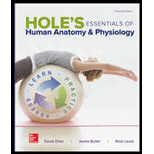
Introduction: The human body is composed of many different types of cells. It functions together and makes up the tissues and organ systems. Cells provide support and structure, facilitate growth by mitosis, allow active and passive transport, generate energy, and create a
Answer to Problem 1CA
Correct answer: c. 30 trillion.
Explanation of Solution
Reason for the correct answer:
A cell is a basic functional, structural, and biological unit of all known organisms. An adult human body consists of about 30 trillion cells. They join and interact, form dynamic organs, tissues, and organ systems. The cells that make a human body have distinctions and similarities. The cells contain the same basic structures however, it considerably varies in the distribution of their component structures and number.
Option c. is given as “30 trillion”.
Hence, the correct answer is option c.
Reasons for incorrect answers:
Option a. is given as “2 billion”.
An adult human body consists of about 30 trillion cells, but not 2 billion cells. Therefore, option a. is incorrect.
Option b. is given as “50 billion”.
An adult human body consists of about 30 trillion cells, but not 50 billion cells. Therefore, option b. is incorrect.
Option d. is given as “8 quadrillion”.
An adult human body consists of about 30 trillion cells, but not 8 quadrillions cells. Therefore, option d. is incorrect.
Hence, options a., b., and d. are incorrect.
An adult human body consists of about 30 trillion cells, but not 2 billion, 50 billion, and 8 quadrillions of cells.
Want to see more full solutions like this?
Chapter 3 Solutions
Hole's Essentials of Human Anatomy & Physiology
 Human Anatomy & Physiology (11th Edition)BiologyISBN:9780134580999Author:Elaine N. Marieb, Katja N. HoehnPublisher:PEARSON
Human Anatomy & Physiology (11th Edition)BiologyISBN:9780134580999Author:Elaine N. Marieb, Katja N. HoehnPublisher:PEARSON Biology 2eBiologyISBN:9781947172517Author:Matthew Douglas, Jung Choi, Mary Ann ClarkPublisher:OpenStax
Biology 2eBiologyISBN:9781947172517Author:Matthew Douglas, Jung Choi, Mary Ann ClarkPublisher:OpenStax Anatomy & PhysiologyBiologyISBN:9781259398629Author:McKinley, Michael P., O'loughlin, Valerie Dean, Bidle, Theresa StouterPublisher:Mcgraw Hill Education,
Anatomy & PhysiologyBiologyISBN:9781259398629Author:McKinley, Michael P., O'loughlin, Valerie Dean, Bidle, Theresa StouterPublisher:Mcgraw Hill Education, Molecular Biology of the Cell (Sixth Edition)BiologyISBN:9780815344322Author:Bruce Alberts, Alexander D. Johnson, Julian Lewis, David Morgan, Martin Raff, Keith Roberts, Peter WalterPublisher:W. W. Norton & Company
Molecular Biology of the Cell (Sixth Edition)BiologyISBN:9780815344322Author:Bruce Alberts, Alexander D. Johnson, Julian Lewis, David Morgan, Martin Raff, Keith Roberts, Peter WalterPublisher:W. W. Norton & Company Laboratory Manual For Human Anatomy & PhysiologyBiologyISBN:9781260159363Author:Martin, Terry R., Prentice-craver, CynthiaPublisher:McGraw-Hill Publishing Co.
Laboratory Manual For Human Anatomy & PhysiologyBiologyISBN:9781260159363Author:Martin, Terry R., Prentice-craver, CynthiaPublisher:McGraw-Hill Publishing Co. Inquiry Into Life (16th Edition)BiologyISBN:9781260231700Author:Sylvia S. Mader, Michael WindelspechtPublisher:McGraw Hill Education
Inquiry Into Life (16th Edition)BiologyISBN:9781260231700Author:Sylvia S. Mader, Michael WindelspechtPublisher:McGraw Hill Education





